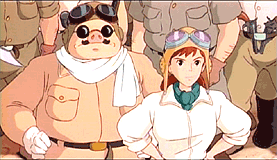|
Newest Reviews:
New Movies -
The Tunnel
V/H/S
The Tall Man
Mama Africa
Detention
Brake
Ted
Tomboy
Brownian Movement
Last Ride
[Rec]³: Genesis
Hara-Kiri: Death of a Samurai
Indie Game: The Movie
Abraham Lincoln: Vampire Hunter
Old Movies -
Touki Bouki: The Journey of the Hyena
Drums Along the Mohawk
The Chase
The Heiress
Show
People
The Strange Affair of Uncle Harry
Pitfall
Driftwood
Miracle Mile
The Great Flamarion
Dark Habits
Archives -
Recap: 2000,
2001, 2002,
2003, 2004
, 2005, 2006,
2007 , 2008
, 2009 ,
2010 , 2011 ,
2012
All reviews alphabetically
All reviews by star rating
All reviews by release year
Masterpieces
Screening Log
Links
FAQ
E-mail me
HOME
| |
The Crimson Pig (Hayao Miyazaki) 1992
 “A pig who doesn’t fly is just an ordinary pig,” says Crimson Pig, the
aviator at the center of Japanese animation master Hayao Miyazaki’s The
Crimson Pig (Kurenai no buta). Rest assured that the hero of this fairy tale
is no ordinary pig, and this is no ordinary animated film. Resembling in its
best moments a fanciful version of Casablanca
with a porcine Bogey in the lead, the movie mixes espionage, dogfights, comedy,
and romance with surprising grace. Unlike most of Miyazaki’s work, the setting
here is quite specific, as the film takes place during the fascist turmoil of
pre-WWII Italy. The evocation of the period is rich with detail, and the passing
commentary on inflation, constantly changing governments, and the entry of women
into the workforce lends a great deal of authenticity to the mood without
sacrificing any of the film’s good nature. The ridiculous devaluation of money
makes a big sack of cash, similar to those that have been seen countless times
in other animated films, take on a satiric bent. The group of women of all ages
from Milan that repair the Pig’s ship are both amusing and surprisingly
competent, and the juxtaposition of their labor and a shot of the Pig rocking a
baby’s cradle is downright hilarious. The multinational and cast seems to
simultaneously reflect the way that Europe was changed by the First World War
and point toward the universality of the film’s subject matter.
“A pig who doesn’t fly is just an ordinary pig,” says Crimson Pig, the
aviator at the center of Japanese animation master Hayao Miyazaki’s The
Crimson Pig (Kurenai no buta). Rest assured that the hero of this fairy tale
is no ordinary pig, and this is no ordinary animated film. Resembling in its
best moments a fanciful version of Casablanca
with a porcine Bogey in the lead, the movie mixes espionage, dogfights, comedy,
and romance with surprising grace. Unlike most of Miyazaki’s work, the setting
here is quite specific, as the film takes place during the fascist turmoil of
pre-WWII Italy. The evocation of the period is rich with detail, and the passing
commentary on inflation, constantly changing governments, and the entry of women
into the workforce lends a great deal of authenticity to the mood without
sacrificing any of the film’s good nature. The ridiculous devaluation of money
makes a big sack of cash, similar to those that have been seen countless times
in other animated films, take on a satiric bent. The group of women of all ages
from Milan that repair the Pig’s ship are both amusing and surprisingly
competent, and the juxtaposition of their labor and a shot of the Pig rocking a
baby’s cradle is downright hilarious. The multinational and cast seems to
simultaneously reflect the way that Europe was changed by the First World War
and point toward the universality of the film’s subject matter.
 The most surprising thing about The Crimson Pig, however, is the amount of warmth that it develops
in the rapport between its characters. Most endearing is the gradual emergence
of friendship between Crimson Pig and Fio, a young female engineer. Though at
times their relationship feels oddly sexual, that dynamism only shows how
complex it is when compared to most animated characters. The romantic longing of
Gina, the restaurateur who has the misfortune of marrying pilots right before
they go down in flames, strikes a stronger chord than one would expect from an
animated work as well. The implication that she really loved the pig all along
casts much of the film in the shadow of regret. The remainder is filled with
breathtaking animated sequences that capture the sensation of flight better than
even most live action movies. A thrilling take off that uses a canal for its
runway is one of the film’s definite highlights, though there’s not a single
sequence in the entire movie that fails to excite. Though children might not
understand the film’s humor when Pig says, “I’d rather be a pig than a
fascist,” I can think of few animated features that seem to have been built
with broader appeal. Although compared to some of Miyazaki’s works The
Crimson Pig might appear a bit slight, there’s little denying its appeal.
The most surprising thing about The Crimson Pig, however, is the amount of warmth that it develops
in the rapport between its characters. Most endearing is the gradual emergence
of friendship between Crimson Pig and Fio, a young female engineer. Though at
times their relationship feels oddly sexual, that dynamism only shows how
complex it is when compared to most animated characters. The romantic longing of
Gina, the restaurateur who has the misfortune of marrying pilots right before
they go down in flames, strikes a stronger chord than one would expect from an
animated work as well. The implication that she really loved the pig all along
casts much of the film in the shadow of regret. The remainder is filled with
breathtaking animated sequences that capture the sensation of flight better than
even most live action movies. A thrilling take off that uses a canal for its
runway is one of the film’s definite highlights, though there’s not a single
sequence in the entire movie that fails to excite. Though children might not
understand the film’s humor when Pig says, “I’d rather be a pig than a
fascist,” I can think of few animated features that seem to have been built
with broader appeal. Although compared to some of Miyazaki’s works The
Crimson Pig might appear a bit slight, there’s little denying its appeal.
* * * 1/2
4-16-02
Jeremy Heilman
|